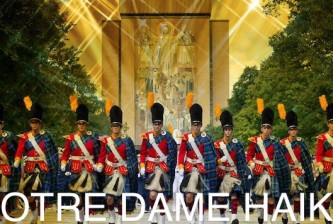
Everett Golson has been officially named the starting quarterback at Notre Dame for the 2012 season opener versus Navy and now it's time to project out all of his amazing stats, wins, trophies, and more. Someone else can do that. We need to start by attempting to decipher how often this young man is gonna turn over the rock in the passing game. Tommy Rees threw a few too many big picks in 2011 and Brian Kelly proclaimed "taking care of the football" as priority #1 for whomever would seize the job. Let's all pretend that it shouldn't always be the #1 priority of the quarterback. Irish fans are well versed, recently, in the game-changing power of the terrible turnover. If Everett Golson can limit the damage in this area, which Kelly claims he did magnificently during Fall Camp, then the Irish should present a formidable challenge to every member of the difficult 2012 slate.
Can I first puff out my chest just a little before delving into the topic at hand? The first Notre Dame article I ever posted while writing at my old stomping grounds was just over a year ago called Handicapping The Quarterbacks. Behold the terrible format and barely better writing. It was a Herring Bone primer on the 2011 competition between Crist, Rees, Hendrix and true freshman early enrollee Everett Golson that 15-20 Irish fans accidentally clicked on. I made a couple of bold statements that early August night and I'll unqualify myself at first with this one:
Dayne Crist will account for 3,200+ Yards & 33 TDs. He'll get a 1st Round NFL Draft Grade and enter.
That's not exactly what transpired after he was chosen to start against South Florida. Later, after that dead-wrong declaration, I moved onto Everett Golson, whom I tabbed as the "unofficial #2 QB" for 2011 and opined the following:
I am prepared to label Golson as the first BCS game winning QB at Notre Dame …
He should be running this offense wild in 2012 and beyond while shattering QB records in South Bend. He is built to lead this kind of attack. What Golson (can do) is the most important aspect of these (spread) offenses: he is an agile quarterback who can absolutely undress teams with pinpoint accuracy when they try to roll up and stop the run/option/screen/pitch game.
Again – first post about Irish football by a true novice. The announcement of the young man's rise to the top is moderately assuring that I might know what the hell I'm talking about sometimes. Sometimes. The Crist analysis will keep me grounded in the short term. Now that we know Everett will get his chance, like Crist and others before, to throw backbreaking interceptions in real games – it's a good time to check in on what to expect from Golson in what will be Job Assignment #1: Protect the Football.
We'll bring our old pal Tommy Rees along for comparison during this statistical jaunt. He'll have quite a bit of free time over the next week, so I'm sure he's happy to help the team in some way. Rees, whom we can all agree threw way, way too many interceptions, tossed 14 in 2011. He attempted 411 passes and gave ND's opponent the ball every 29.4 times he put it in the air. The bigger problem? He was attempting over 33 passes per game (discounting Stanford). Rees's restricted skill set forced the offense to often abandon the run game against quality stacked defenses and he rarely made teams pay for this transgression.
The comparison comes when we look back at how Brian Kelly used QBs with varying styles while coaching at Cincinnati. Kelly used Tommy Rees much like he used Tony Pike during 2009's undefeated regular season. Pike was airing it out nearly 39 times/game. The difference between Pike & Rees? Pike only threw interceptions once every 62 attempts, half as often as 2011 Rees, and the Bearcats racked up the wins. Pike went down with injury midseason and the much more athletic Zach Collaros took the reigns for 4 games. Kelly adjusted magnificently on the fly to his QB's strengths. Collaros, a true sophomore with no experience (ahem), kept the Bearcats train on the tracks while averaging 12 fewer throws per game than Tony Pike. Collaros operated a more run-oriented attack that continued to light up the scoreboard and bring home the victories. This stretch of coaching by Brian Kelly is likely what took him from calling plays at Cincy to boarding a private jet to South Bend to helm the Fighting Irish. It also gives us a glimpse of what Kelly might want to do with Golson in 2012.
With a high quality athlete at quarterback in Zach Collaros, Kelly had him throwing the ball 26 times per game. Toting a playbook full of screens, swings, and dumps in the flat, this sounds close to a Golson 2012 projection. Collaros ran the ball 11 times per game in 2009, but Golson is unlikely to match that because his rushing style is significantly less bruising. I'd say 28 passes per game is a better projection for the leader of a team that should pound the running game very effectively.
This tale of the tape is simple – even if Golson's INT ratio is 2011 Tommy Rees bad, he'll still throw far fewer than Tommy because he won't be putting the ball in the air nearly as often. Kelly's QB history clearly shows us these tendencies in play-calling and we shouldn't expect him to have made system-wide changes to personnel in order to continue doing the same thing that hasn't worked with Rees. Everett Golson Interception Math:
- TERRIBLE/BENCHED: 12+ INTs – If Golson were to match Tommy Rees dreadful INT ratio from 2011 (1 INT/29 ATT), he'd throw twelve picks. Allegedly already better at protecting the ball than Tommy, this is really worst case scenario and still better than Tommy could accomplish with drastic improvement. It's doubtful Golson would last the full season as a starter if his ratio hovers near Tommy's from last fall. This is 6-7 win territory
- FAIR BUT ON THE HOT SEAT: 9-11 INTs – If Golson is only slightly better than Rees in 2011, throwing an INT every 35 passes, he'll throw 8-9 INTs and find his seat warming for Gunner Kiel next spring. 8-9 INTs also puts 9 wins as a stretch.
- GREAT DEBUT SEASON: 5-8 INTs – Now entering "once every other game" interception territory after two seasons of the Irish tossing away an average of one each outing. For a sophomore throwing the ball 25+ times/game, this would be a fantastic result and most likely equal 9 wins or more.
- BCS GAME BOOKED – <5 INTs – If Everett Golson starts and plays in every 2012 regular season game while throwing fewer than 5 interceptions, we'll be play after New Years in a game that matters.
I don't think any of us can foresee Everett Golson throwing interceptions in soul-crushing bunches like those often prone to #11. On the contrary, it's wildly optimistic expecting a first year college starter, one expected to improvise, to tally fewer than 7 or 8 INTs in a spread offense. If Golson can limit his mistakes to one every 40+ passes, then Notre Dame should pull off an upset or two and beat everyone on the schedule who Notre Dame "should" beat. As we've seen many years before, that's always easier said than done. Bold predictions for Golson's 2012 stats:
2700 Passing Yards, 300 rushing Yards, 25 Passing TDs, 4 Rushing TDs, 7 INTs, 64% Completion
Per Game Averages: 225 Pass Yard, 25 Rushing Yards, 2.1 TDs, 0.3 Rush TDs, 0.6 INTs
If these numbers come to fruition, Notre Dame should be playing USC for a shot at a BCS game and double digit wins. If all these numbers stay the same but you raise the INTs just 2 or 3, we've got a problem whose answer we've seen called on before. We'll hope it doesn't get to that point
Go.Irish.
Catch me on Twitter @ManCaveQB & check out my new podcasts featuring QB breakdowns from 2012 ND Football alum Matt Mulvey and other great guests. This week: John Walters & Jordan Schultz talking Irish. For iTunes search "TNNDN".






















